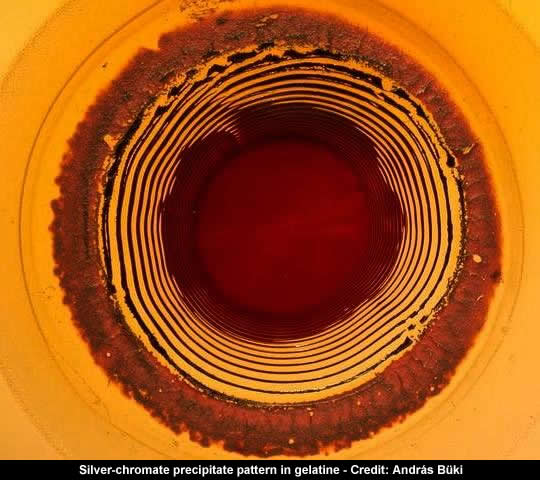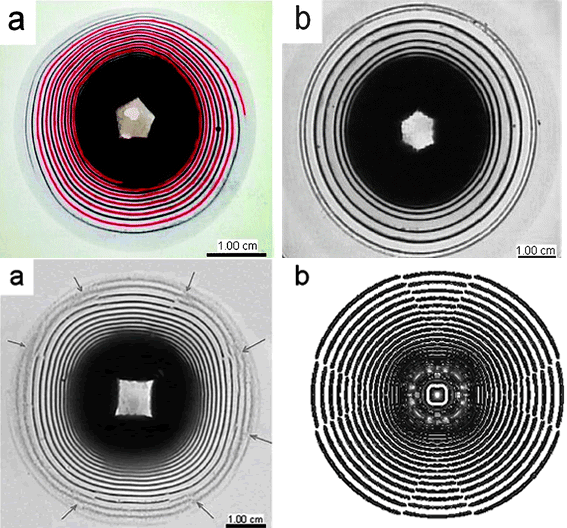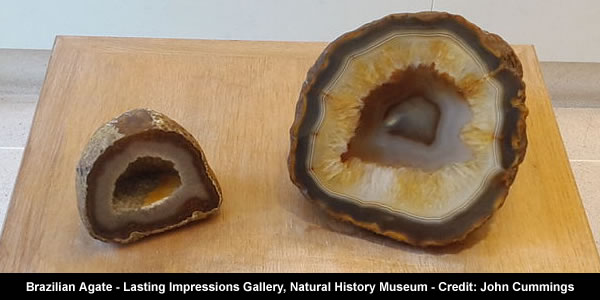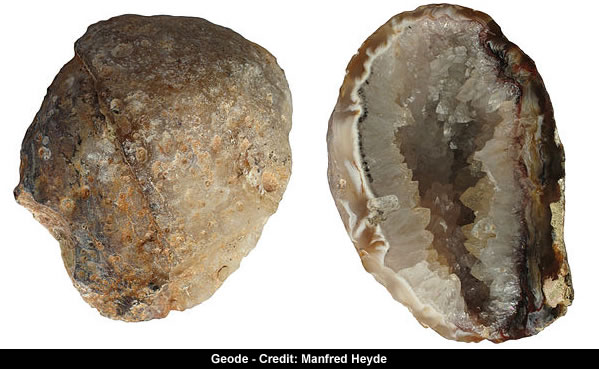Liesegang Rings have vexed mainstream scientists for over a hundred years.
Liesegang rings are a phenomenon seen in many, if not most, chemical systems undergoing a precipitation reaction, under certain conditions of concentration and in the absence of convection.
https://en.wikipedia.org/wiki/Liesegang_rings
Although Liesegang Rings are usually demonstrated using a gelling agent [such as gelatine] they also occur in solid and gaseous chemical systems.
The Liesegang Phenomenon has been studied for over a 100 years and academia has generated a plethora of theories that attempt to explain the underlying science.
…
Ultimately, no single theory has managed to explain all forms of the Liesegang Phenomenon and many scientists believe that periodic precipitation is not the result of a single effect.
…
However, there is clear evidence that indicates the Liesegang Phenomenon is not just a “chemical” process of periodic precipitation.
…
Firstly, it has been observed that “Liesegang bands will appear after the gel has been exposed to sunlight”.
…
Secondly, there is evidence that suggests Liesegang Ring patterns can be regulated by an electric current so that information can be encoded into the precipitation pattern.
The archetype two-dimensional Liesegang pattern consists of concentric rings that increase in width and diameter as they grow outwards to leave a central circular void.
However, two-dimensional Liesegang patterns can form “a variety of patterns, such as dislocations (radial alleys of gaps), branches (anastomoses) and spirals” with a central polygonal void.
Two-dimensional Liesegang patterns formed when the boundary between electrolytes is polygonal display a variety of patterns, such as dislocations (radial alleys of gaps), branches (anastomoses) and spirals, many of which can be found in nature.
Each vertex of the polygon can produce a pair of dislocation lines or branch lines.
The effect caused by a vertex decreases with the number of vertices.
Double-armed spirals are observed in experiments with a pentagonal boundary.
Hexagons, which begin to approach smooth circular boundaries, do not give rise to dislocations, but instead yield concentric precipitation rings.
A simple model of nucleation growth enables us to simulate dislocations and spirals consistent with those seen in our experiments.
Precipitation patterns with polygonal boundaries between electrolytes
Changwei Pan, Qingyu Gao, Jingxuan Xie, Yu Xia and Irving R. Epstein
Phys. Chem. Chem. Phys., 2009,11, 11033-11039http://pubs.rsc.org/en/content/articlelanding/2009/cp/b904445k#!divAbstract
See: https://malagabay.wordpress.com/2013/10/29/liesegang-rings-2-spirals-helices-and-polygons/
Three-dimensional Liesegang patterns in Agate nodules frequently surround a central void.
Agate is a cryptocrystalline variety of silica, chiefly chalcedony, characterised by its fineness of grain and brightness of color.
Although agates may be found in various kinds of rock, they are classically associated with volcanic rocks and can be common in certain metamorphic rocks.
However, “no universal agreement exists concerning the formation of agate bands” [or the associated cavities] because the mainstream prefers to ignore Liesegang phenomena.
To be perfectly honest, no universal agreement exists concerning the formation of agate bands, either concentric or horizontal, but it is apparently a fairly slow process that requires stable conditions.
Rocks and Minerals Magazine – Media Reviews by Robert B. Cook
http://www.rocksandminerals.org/Back%20Issues/2014/July-August%202014/media-reviews-full.htmlHowever, contemporary geologists seems to have long forgotten that “vein of gelatinous silica” [found in the Simplon tunnel over a hundred years ago] and Liesegang Rings.
Modern geology, apparently, has manufactured their own version of the “immaculate conception” by devising a cunning plan whereby agate rings are formed by the successive “deposition of layers”.
…
Rainer Hoffmann-Rothe also states that this “theory is easy to disprove” because “one generally observes a structural diversity of adjacent agates”.
Rocks with cavities are called geodes and may be lined with crystals of “calcite, pyrite, kaolinite, sphalerite, millerite, barite, celestite, dolomite, limonite, smithsonite, opal, chalcedony and” [most abundantly] “macrocrystalline quartz”.
Geodes are geological secondary structures which occur in certain sedimentary and volcanic rocks.
They are themselves of sedimentary origin formed by chemical precipitation.
Geodes are essentially hollow, vaguely spheroid to oblate masses of mineral matter…
Geodes commonly have a chalcedony (cryptocrystalline quartz) shell lined internally by various minerals, often as crystals, particularly calcite, pyrite, kaolinite, sphalerite, millerite, barite, celestite, dolomite, limonite, smithsonite, opal, chalcedony and macrocrystalline quartz, which is by far the most common and abundant mineral found in geodes.
Geodes are found mostly in basaltic lavas and limestones.
In 1977 Georgi Gladyshev published his pioneering cosmology based upon Liesegang’s theory of periodic condensation.
The pioneering cosmology of Georgi Gladyshev [originally published in 1977] embodies the concept of As Above, So Below by explicitly stating that “Liesegang’s theory of periodic condensation can be used to explain the empirical Titius-Bode rule of planetary distances”.
…
Therefore, the “accumulation of gas, plasma and dust” into an interstellar plasma cloud provides a [semi-permeable] closed system within which Liesegang Rings can develop.
…
One surprising implication of Georgi Gladyshev’s cosmology is that the plasma cloud provides an environment that is analogous to the reactant gel typically used in laboratory experiments designed to form Liesegang Rings.
Georgi Gladyshev’s Liesegang Cosmology can clearly be applied to the planets in the Solar System plus the ring and moon systems of the Gas Giants.
Overall, the cosmology of Georgi Gladyshev passes a basic reality check with great ease.
In fact, none of Georgi Gladyshev’s cosmology should really come as a surprise because the Solar System contains several planets with rings systems which clearly morph into orbiting moons systems that increase in size with distance from the centre – just like Liesegang Rings.
Therefore, the next step in exploring Georgi Gladyshev’s Liesegang Cosmology is to review the evidence that indicates the planets in the Solar System contain cavities.










Pingback: The Nature of Time | Louis Hissink's Crazy World
Pingback: Liesegang Cavities: 4 – A Tale of Two Models | MalagaBay